The Art Movement That Favored a Return to Emotion and Nature
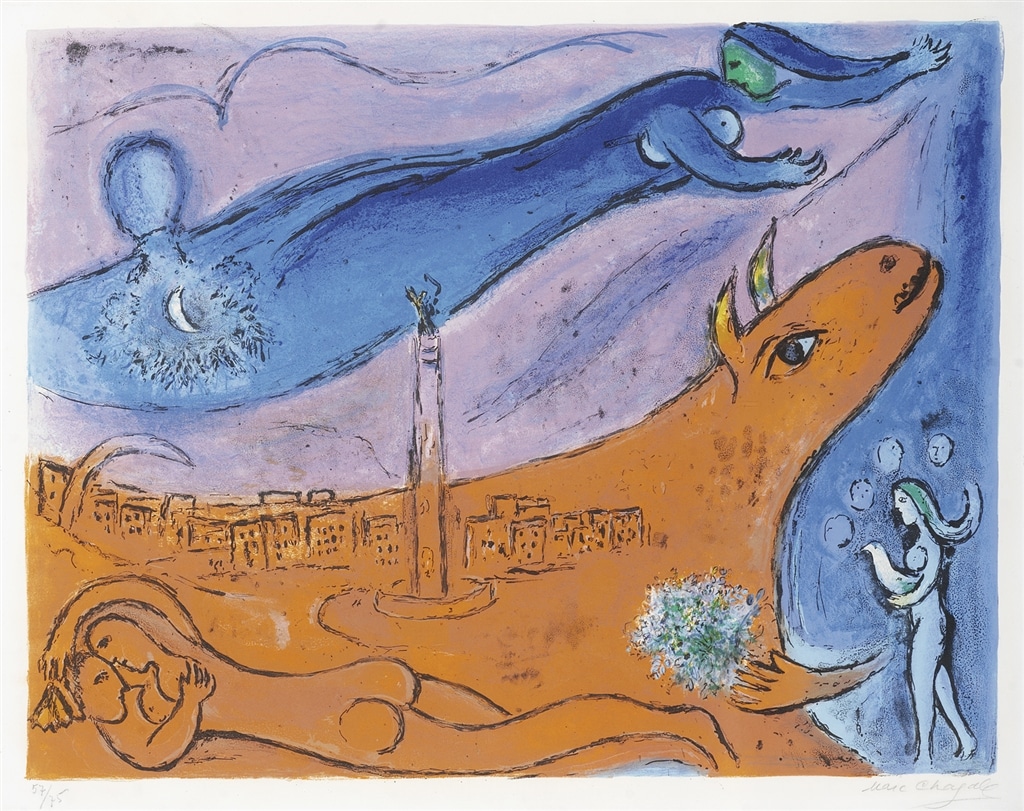
"The Guardhouse" (1954; M. 111), Marc Chagall
In realist art circles, objectivity is the proper noun of the game. Say that an creative person'southward subject is a bowl of fruit, for example. Some would want a painter to describe the fruit in the most accurate fashion possible, with every blemish and curve perfectly rendered.
But what about the artists who don't wish to objectively remove their emotions from the work? Does subjectivity disqualify an artwork from galleries and museums? I'll let Edvard Munch'southward "The Scream," a pioneering piece of work of the Expressionism motion, reply that question for y'all.
What do we mean when we say "Expressionism"? While Impressionism and the works of Impressionist artists like Claude Monet and Pierre-Auguste Renoir sought to describe light, move, and colour equally accurately equally they could in a two-dimensional medium, Expressionism is a lot less concerned about reality.
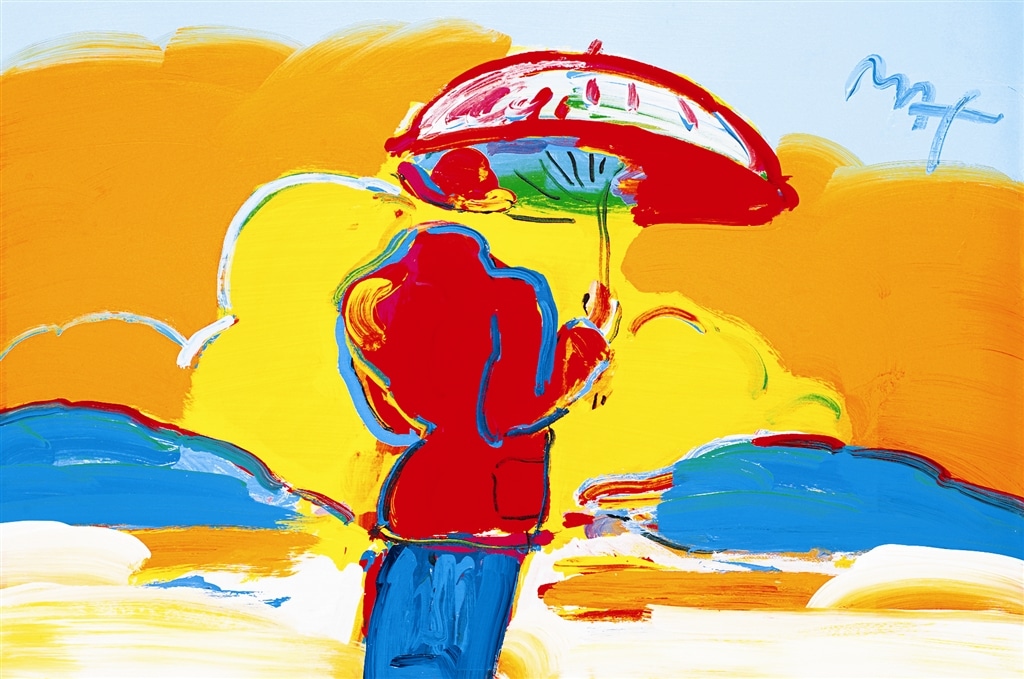
"Umbrella Homo at Sea" (2006), Peter Max
Instead, Expressionism puts the personal and emotional at the forefront of fine art, with field of study matter and accuracy as the final of its worries. In fact, the term "Expressionism" was coined past Czech historian Antonin Matějček in 1910 to specifically hateful the "contrary" of Impressionism.
Granted, it would be incredibly difficult to discover a work of art that lacks any emotion. An artist'south desire to create comes from their emotions, both positive and negative.
Nonetheless, Expressionist artists bring those emotions into their depictions, elevating their emotional interpretations over any sense of trying to convey the objective "truth" of their subjects. By pushing back at centuries of artistic tradition, Expressionism changed the entire landscape of mod art and inspired numerous 21st-century artists to let their emotions take the reins.
But how did this move brainstorm in the first place?
Bridge Over Impressionist Waters: The Origins of Expressionism
At the plough of the 20th century in Western Europe, club was evolving at a rapid pace. Intense industrialization had taken the continent by storm, with innovations in the manufacturing and communication worlds creating a sense of unease in the full general public. The breakneck growth of engineering and the urbanization of large cities brought with it feelings of isolation and disconnect with the natural world.
Understandably, these emotions and anxieties began bleeding into the fine art of the era.
The two art groups that created Expressionism every bit we know it today—Die Brücke and Der Blaue Reiter—formed in Germany in the early 20th century. In Dresden, four architecture students Fritz Bleyl, Erich Heckel, Karl Schmidt-Rottluff, and Ernst Ludwig Kirchner created a communal fine art group called Die Brücke (The Span). They wanted to serve equally a "bridge" to the future of art by evoking intense emotional responses using unnatural forms, colors, and compositions, all inspired past the modern world.
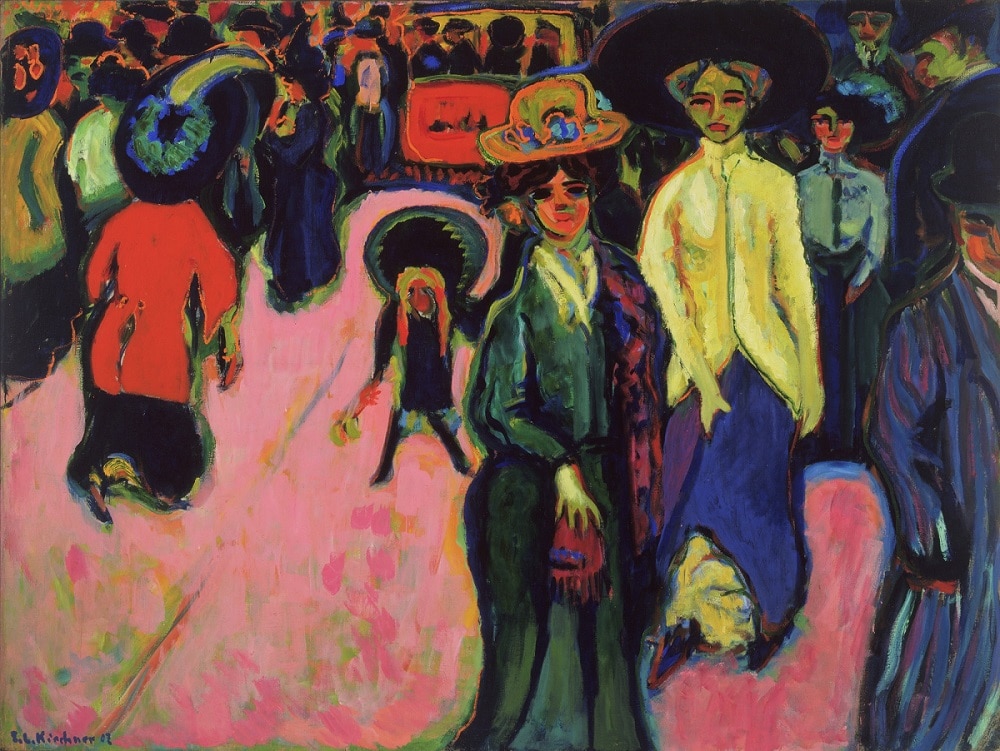
"Street, Dresden" (1919), Ernst Ludwig Kirchner (Image via MOMA)
Their works shared similarities with the Fauvism motility in France, led by Henri Matisse, in their usage of bright colors and atypical shapes to convey emotion.
In its founding, Dice Brücke was meant to be a youthful response to centuries of realism in art. In a 1906 manifesto made on a woodcut print, Die Brücke wrote, "With a belief in standing evolution, in a new generation of creators as well as appreciators, nosotros phone call together all youth. And as youth conveying the future, we intend to obtain freedom of motion and of life for ourselves in opposition to older, well-established powers. Whoever renders directly and authentically that which impels him to create is one of us."
Through this call to activity, the young artists of Western Europe were tasked to build a new art movement—Expressionism.
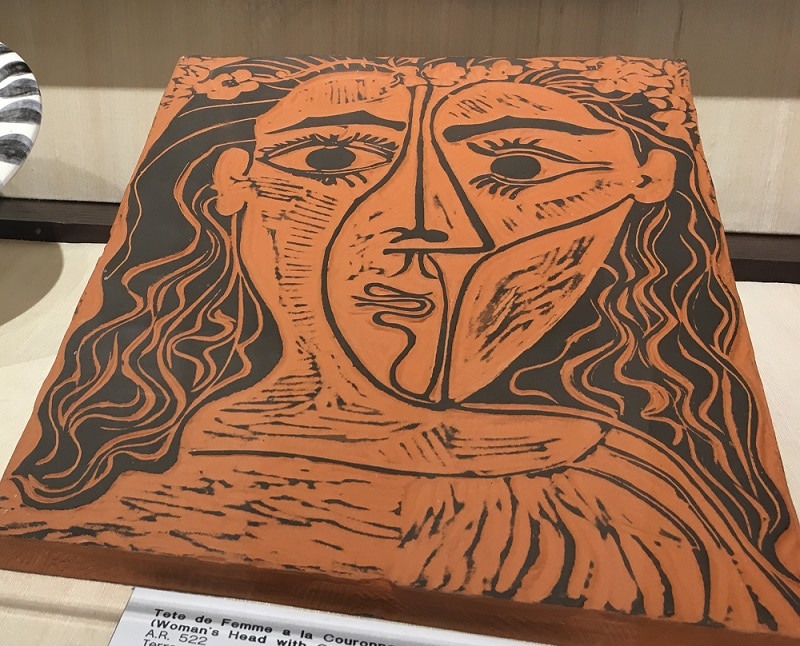
"Tete de Femme a la Couronne de Fleurs" (1964), Pablo Picasso. Currently on display at Park W Museum.
Die Brücke artists concentrated largely on depicting the mass chaos of the new urbanization surrounding them, painting cityscapes with exaggerated, jagged peaks and vibrant colors. Pushing boundaries more than the Fauves did, Die Brücke brought the hugger-mugger German culture of nightclubs and lower-class decadence into their art while withal conveying their ain personal sense of emotion and unrest.
A second group, Der Blaue Reiter (The Blueish Rider), named after the Wassily Kandinsky painting, was formed in Munich in 1911. This art collective was made of Russian emigrants like Kandinsky, Alexej von Jawlensky, and Marianne von Werefkin and German artists Franz Marc, August Macke, and Gabriele Münter. The Kandinsky painting was chosen equally the group's namesake because of its depiction of a figure on horseback riding from reality into a spiritual and emotional realm.
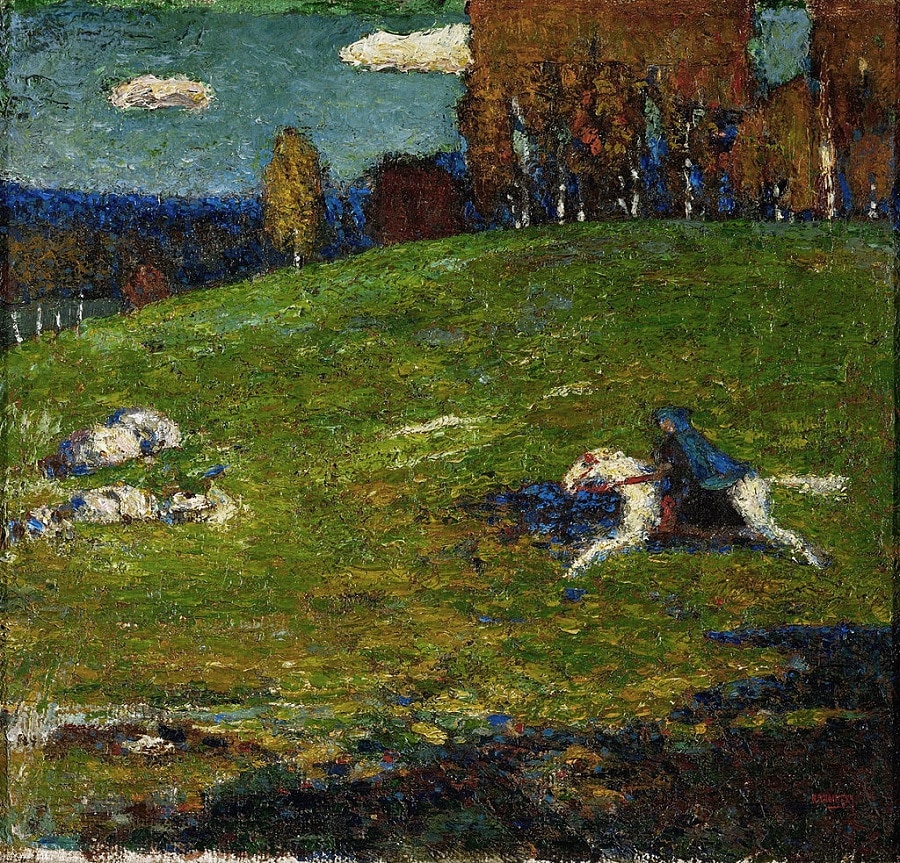
"Der Blaue Reiter" (1903), Wassily Kandinsky (public domain)
If the Kandinsky painting didn't give it away, Der Blaue Reiter artists were fascinated with rendering the spiritual as opposed to the concrete. While their styles varied, interests in Primitivism and the emotional landscape dominated their works.
Every bit opposed to Die Brücke, Der Blaue Reiter was a large forcefulness in the development of Abstract Expressionism. Expressionism and Abstract Art both reject realism and try to convey emotions, withal, Expressionism retains a sense of course and symbolism while Abstract Fine art abandons all recognizable images. Der Blaue Reiter merged these ideas, creating a completely new branch of Expressionism that influences modern art to this solar day.
At the outbreak of the First Earth State of war, Die Brücke and Der Blaue Reiter disbanded, but their legacy lives on. As seen by these artists below, Expressionism continues to grow in popularity and is still expert in the 21st century.
Expressionism in the 20th and 21st Centuries
From the genesis of Expressionism to today, artists have embraced the motion'south focus on capturing emotions through evocative imagery. Hither are 3 artists who brought their own unique Expressionist energy to dissimilar moments over the past 100 years.
Marc Chagall
If we're ranking the most powerful emotions, it'due south hard to top dearest. Simply how tin can something as complex as dearest make its fashion onto a canvas? In the words of Russian-born artist Marc Chagall, "In our life, there is a single colour, as on an artist's palette, which provides the meaning of life and art. It is the colour of honey."
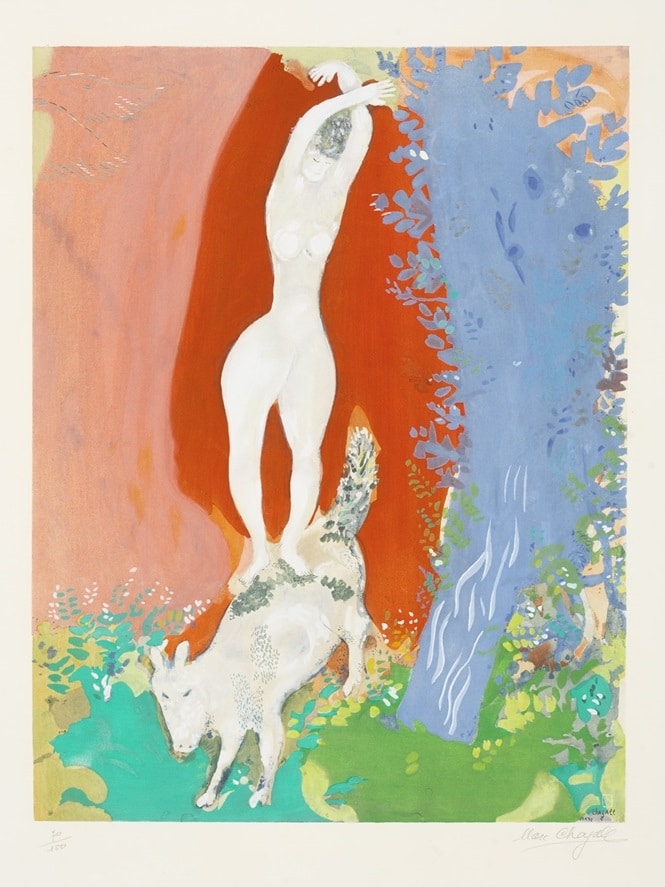
"Femme de Cirque" (1960), Marc Chagall
Later fleeing the jailing of Jewish artists in St. Petersburg and studying fine art in Paris in the early on 20th century, Chagall returned to his hometown of Vitebsk, Russia to develop his Expressionist mode. Taking what he learned from the Surrealists and Fauves in Paris, Chagall built upon their traditions of channeling the unconscious and abandoning realist form to return pure emotions through his artwork.
A large corporeality of Chagall's inspiration initially came from his wife Bella Rosenfeld and, after her death, from other relationships throughout the rest of his life. While his works maintain some connection to form as opposed to fully embracing abstraction, his use of bright, vibrant colors and varying techniques make his emotions apparent.
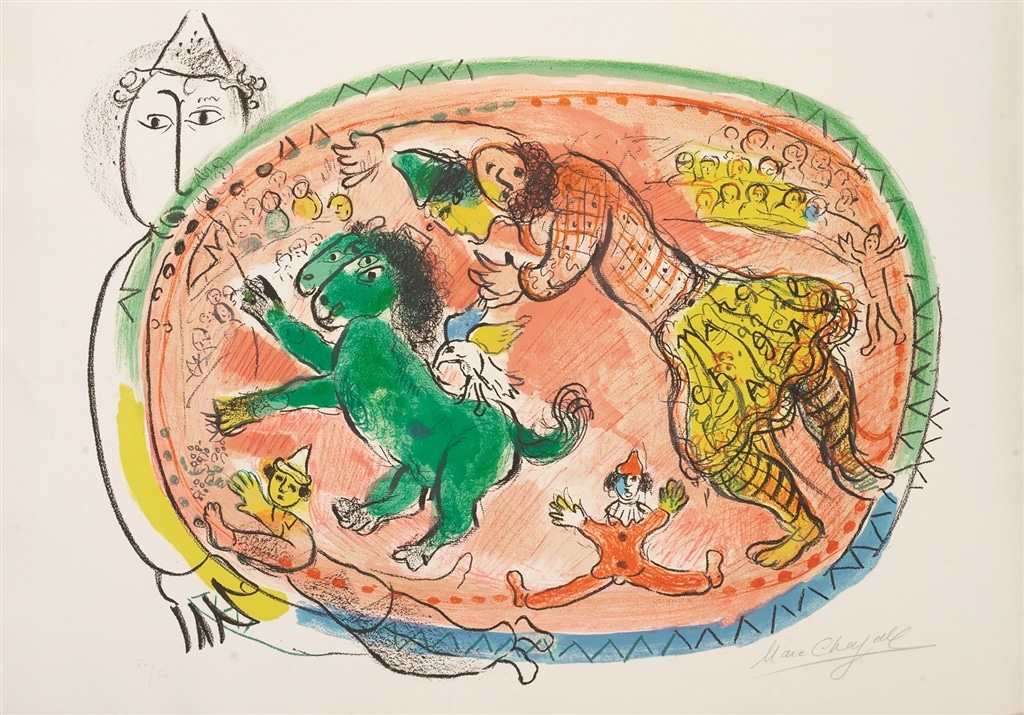
"Le Cercle Rouge" (1966; Chiliad. 440), Marc Chagall
Chagall reiterated repeatedly that his faith in love was the master inspiration for his fine art. "But love interests me and I am only in contact with things that revolve around honey," he in one case said.
Peter Max
Expressionism could also be plant all over American Pop Art and visual art of the 1960s. With and so many emotions present in that era of U.South. politics, creatives turned to their art to express themselves. And, information technology's safe to say that few artists had more of an bear upon on '60s Expressionism than Peter Max.
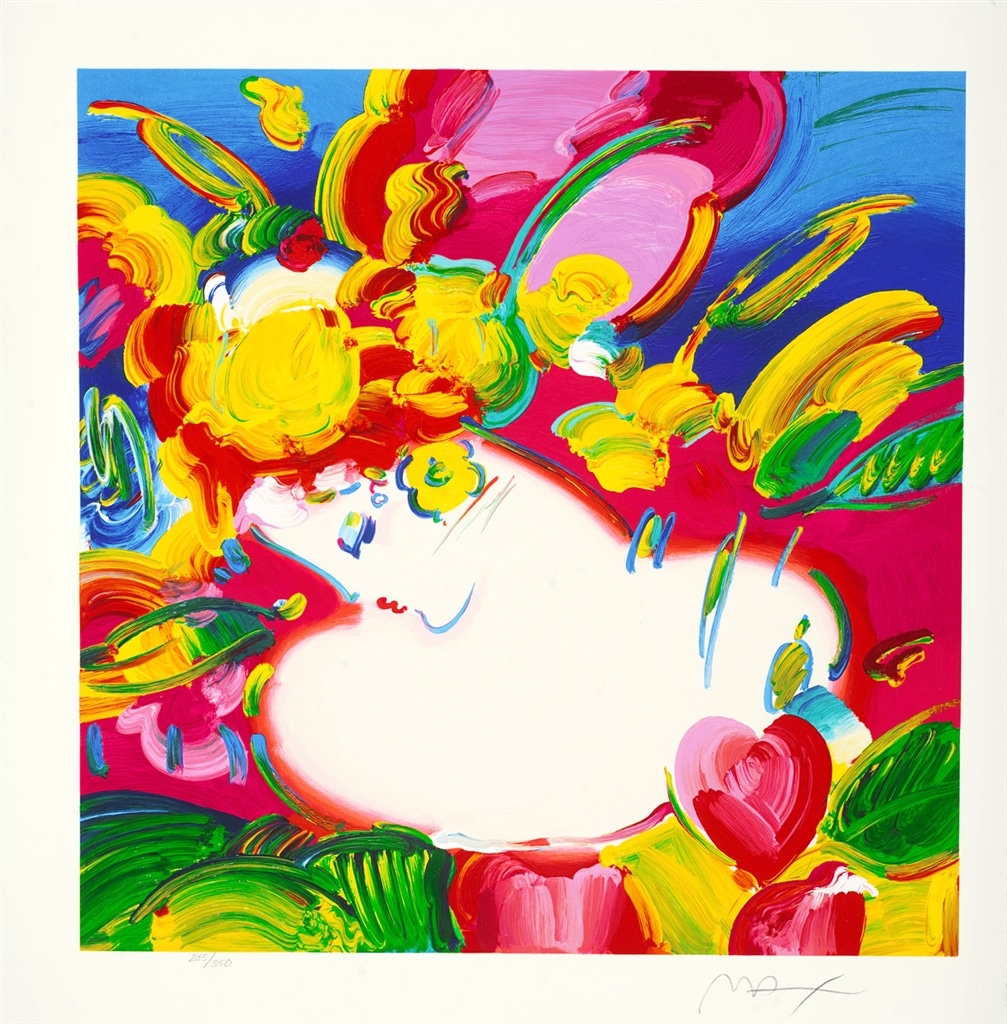
"Flower Blossom Lady" (2012), Peter Max
Max's family traveled extensively during his formative years. Living in Germany, China, Israel, and Brooklyn before starting his adult life, Max quickly adult an obsession with fine art that followed him everywhere. From a young historic period, Max was fascinated with how color and audio interact, creating canvases meant to convey auditory subjects through colour.
Information technology was when Max moved to Brooklyn in the 1950s that he was first able to channel his beloved of American pop culture into his fine art, pioneering the Neo-Expressionist motion. In 1961, Max opened a graphic blueprint studio with his friends and began receiving national praise for his psychedelic Expressionist works, full of abstraction and raw emotion.
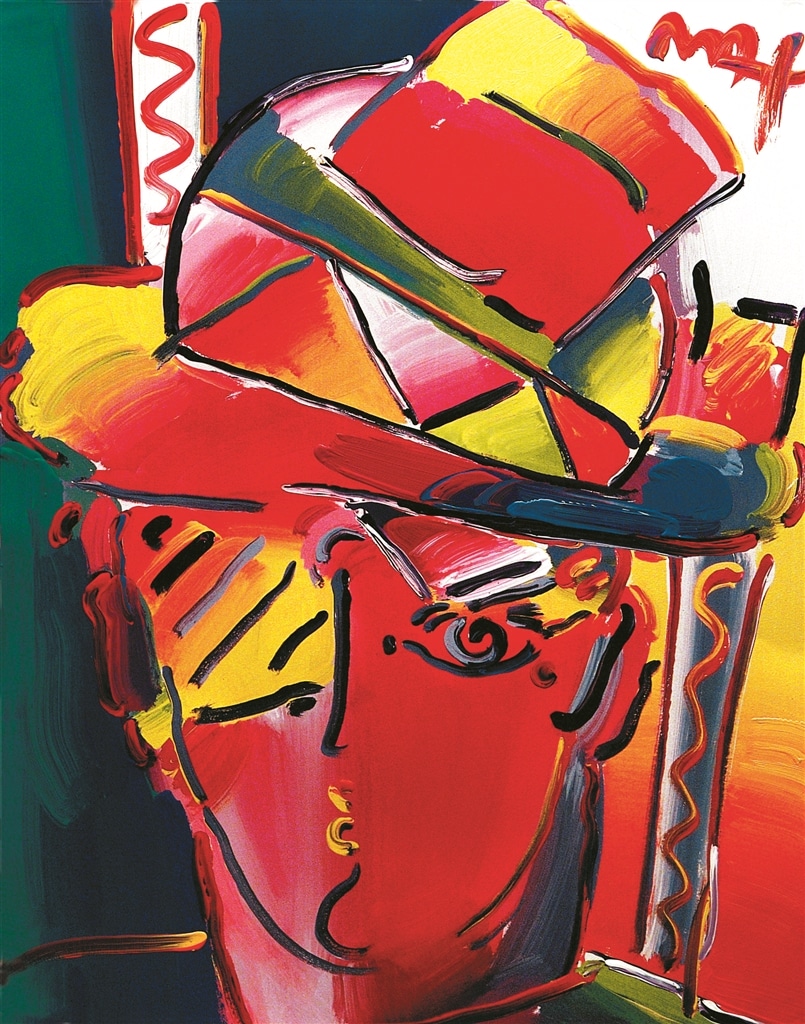
"Naught Prism' (2012), Peter Max
Like almost Popular Artists and graphic designers, Max's work wasn't bars to galleries or museums. Many of his prints could be found on moving-picture show posters, billboards, or hanging on the walls of college dorm rooms. His artwork became so ubiquitous during this period that Max truly helped set the emotional tone of the 1960s through his fine art.
LEBO
Carrying the torch for modernistic Expressionism, David Le Batard, otherwise known as Lebo, blends folk art, comic visuals, and graffiti influences to create his signature "Postmodern Cartoon Expressionism."
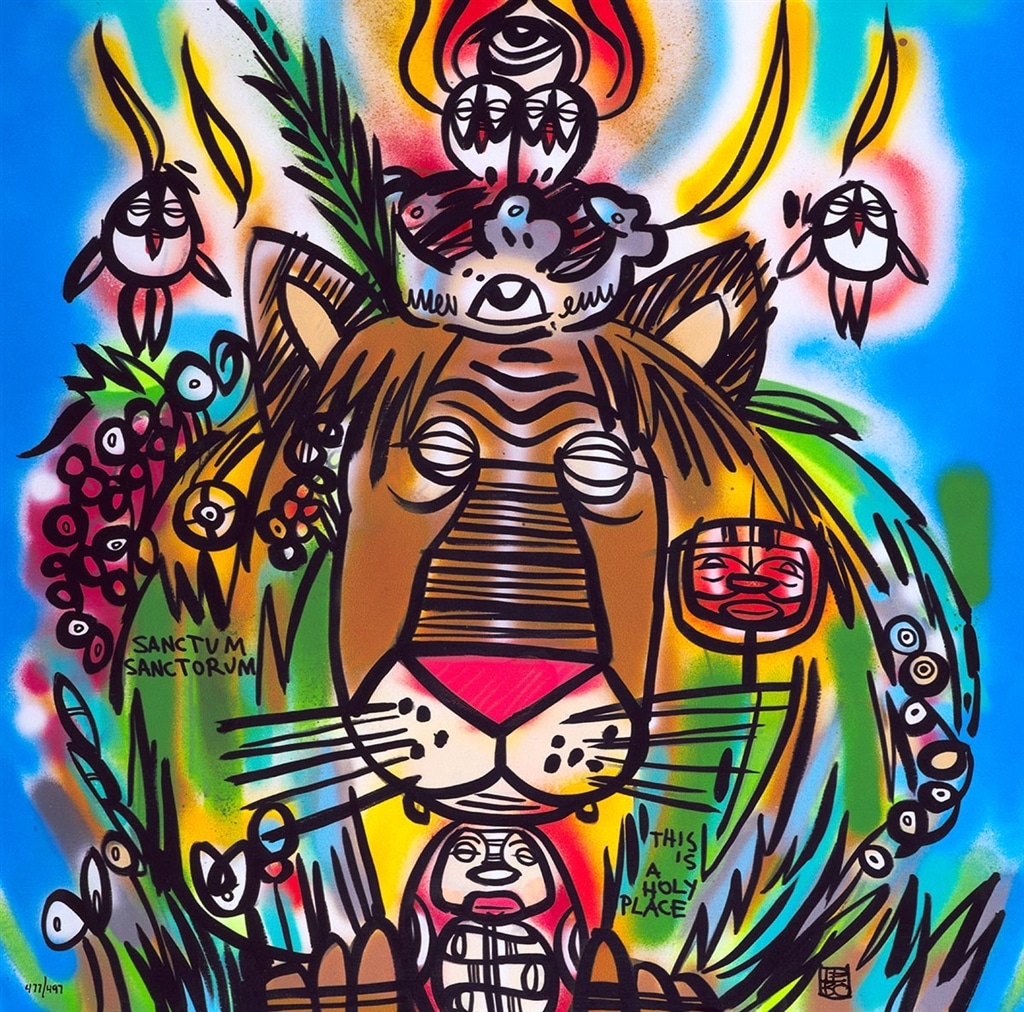
"This is a Holy Place" (2019), David "Lebo" Le Batard
Lebo, the child of Cuban immigrant parents, was surrounded by Cuban art from an early on age, which influenced his future works immensely. Like well-nigh children, he was fascinated with cartoons and brought this enthusiasm into his fine art, creating graphic illustrations with varying brushstrokes and styles.
Above all things, Lebo is a storyteller. Instead of simply recreating visuals, Lebo reinvents and builds emotional stories through his abstract imagery and calligraphy.
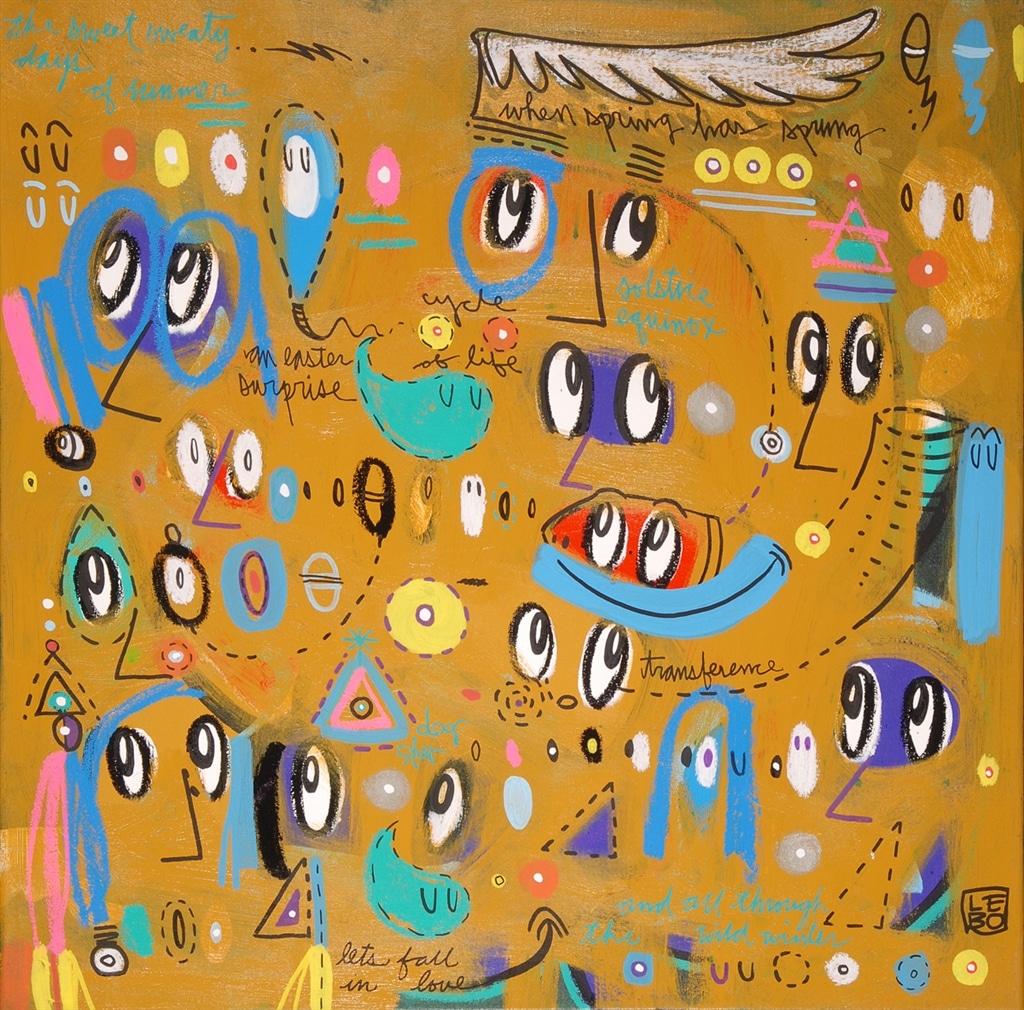
"Through the Seasons" (2016), David "Lebo" Le Batard
This connexion to storytelling involves large amounts of enquiry to reach the emotional response he looks for from his works. "Within the storytelling part and narrative aspect of what I do, the research that goes into it is the cornerstone of it," he says.
A proud believer in the postmodern theory that history is continuous and culture has no concrete boundaries, Lebo's works display cantankerous-cultural narratives through his vibrant, Expressionist compositions.
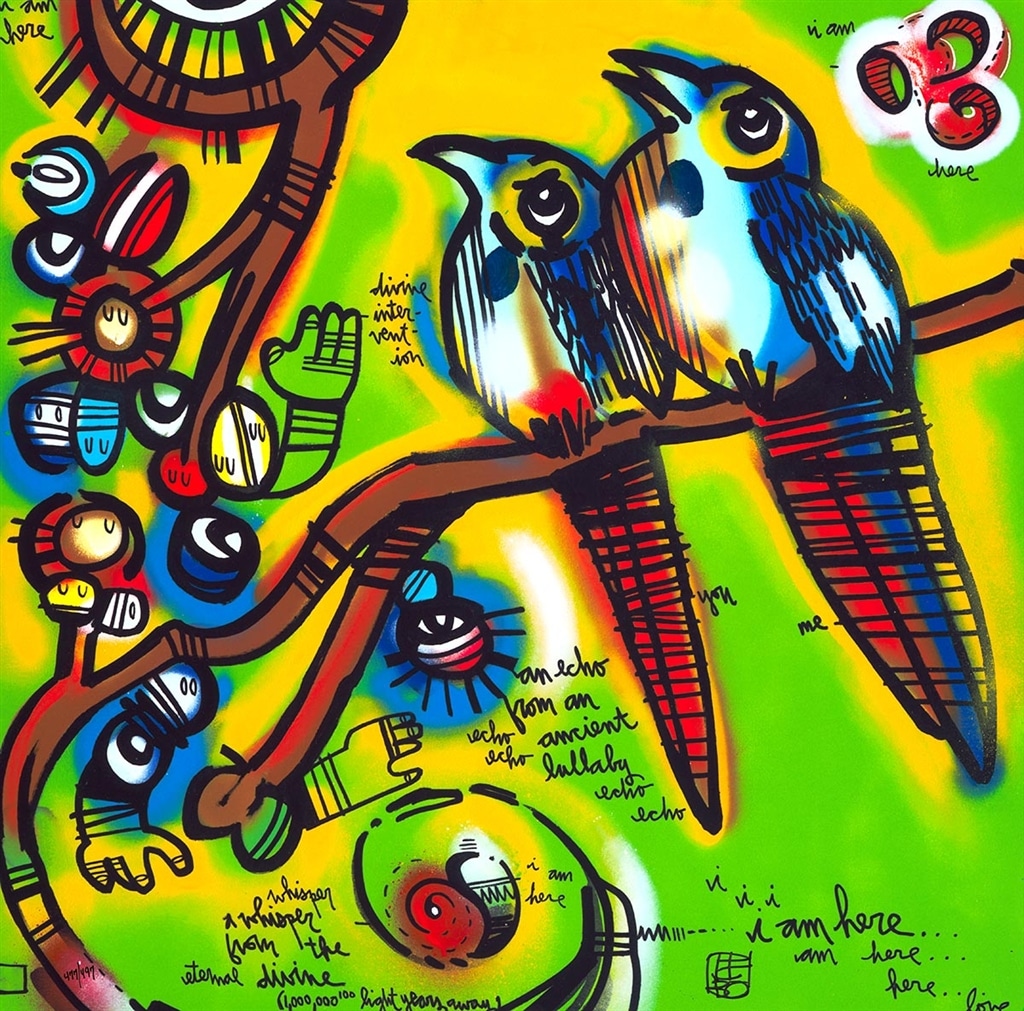
"I am Hither" (2019), David "Lebo" Le Batard
"It's discovering similarities, researching them, and the themes that I want to fill my life with, so that is honey, spirituality–things that I call back speak to something much higher," he says.
Without emotion, art as nosotros know it wouldn't exist. Artists are driven to create as a way to grapple with their feelings and viewers are drawn to their works because these emotions are universal.
The Expressionists took this relationship and asked their audiences, in the words of Peter Frampton, "Do yous feel like we do?"
Ix times out of ten, the answer was, and still is, "Yeah."
If you lot're interested in collecting Expressionist art or want to know more about artists who specialize in Expressionism, register for our heady online auctions or contact our gallery team at i-800-521-9654, ext. four or at sales@parkwestgallery.com.
Larn MORE Almost Art AND Fine art MOVEMENTS:
- What Is Surrealism? How Fine art Illustrates the Unconscious
- What Is Abstract Art? How Artists Make Something Out of Nothing
- Lebo Breaks Down His Postmodern Cartoon Expressionism
- Defining Cubism: Art'southward Power to Shatter and Build Again
Source: https://www.parkwestgallery.com/what-is-expressionism-art/#:~:text=Instead%2C%20Expressionism%20puts%20the%20personal,the%20last%20of%20its%20worries.
0 Response to "The Art Movement That Favored a Return to Emotion and Nature"
Post a Comment